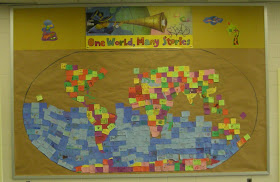My second family storytime for this summer was "Folktales from Asia." I told a story primarily based on Lily Toy Hong's Two of Everything. This title was recommended as being a good one to adapt for the flannel board in Travel the Globe: Multicultural Story Times (p. 51). I searched the web to find other versions of the story. I came across a nice animated version called "The Magic Pot." I wrote my own version called "Pot Luck." It can be found as a Google document here.
To tell the story I used our magnet board and a black plastic pot. The duplicates and coins were placed in the pot beforehand. I definitely recommend using a bowl or pot along with the board figures. The highlight of the story was when the farmer's wife fell into the pot and two wives came out. I don't think it would be as effective with a two dimensional pot (not to mention the difficulty of manipulating the figures). The coins are just circles cut from construction paper. I punched a hole in the center to make them look like old Chinese coins. I made enough to double to 16 but when I told the story I only went up to 8. The older children were able to correctly guess how many coins would come out of the pot, though one did gleefully yell out 6. The parents enjoyed this story as much as the children did.




